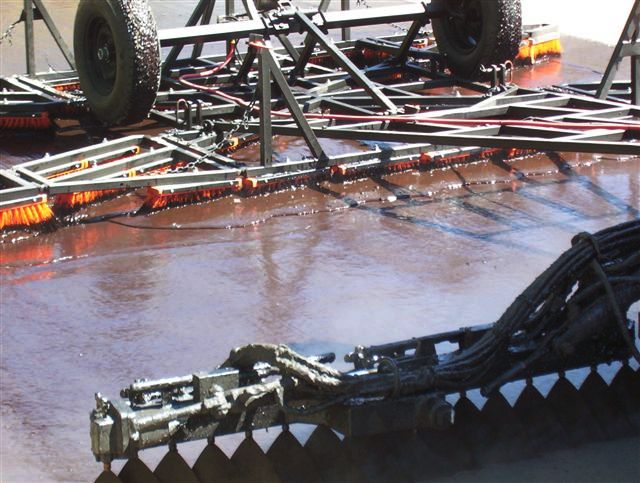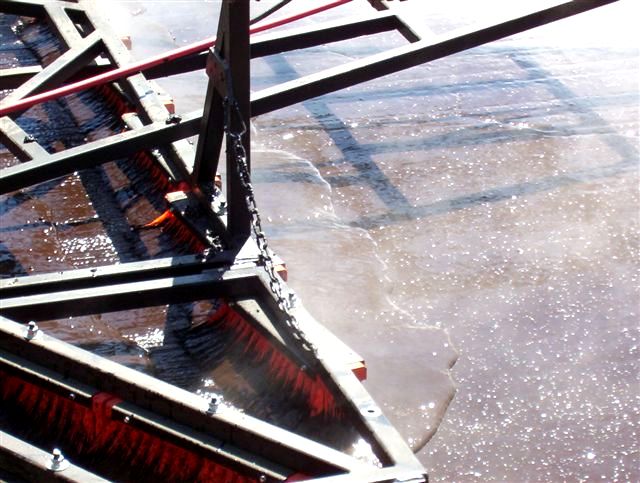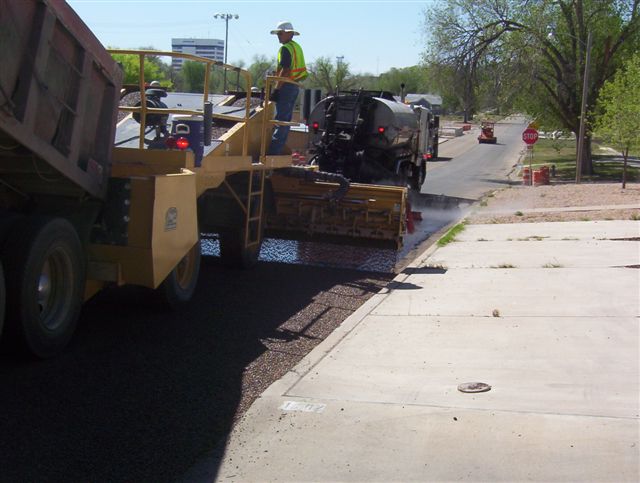What: A sc rub seal is a crack-filling, sealing and rejuvenating seal accomplished in a series of steps. An asphalt emulsion is sprayed and swept or squeegeed (scrubbed) mechanically with a drag or broom into small cracks and other surface imperfections. The emulsion may also contain polymers, crumb rubber or rejuvenating oils. A chip spreader then applies a layer of fine aggregate, which is also broomed into the surface, followed by another drag broom, forcing the sand into the emulsion-filled cracks and voids. (If larger aggregate is used, it is applied using standard chip seal procedures.) A pneumatic tire roller is then used over the seal. The excess sand or aggregate is broomed off the roadway a couple of hours after application. Typical application rates are 0.15 to 0.40 gal/yd2 of emulsion and 10 to 20 lbs/yd2 of sand or fine aggregate.
rub seal is a crack-filling, sealing and rejuvenating seal accomplished in a series of steps. An asphalt emulsion is sprayed and swept or squeegeed (scrubbed) mechanically with a drag or broom into small cracks and other surface imperfections. The emulsion may also contain polymers, crumb rubber or rejuvenating oils. A chip spreader then applies a layer of fine aggregate, which is also broomed into the surface, followed by another drag broom, forcing the sand into the emulsion-filled cracks and voids. (If larger aggregate is used, it is applied using standard chip seal procedures.) A pneumatic tire roller is then used over the seal. The excess sand or aggregate is broomed off the roadway a couple of hours after application. Typical application rates are 0.15 to 0.40 gal/yd2 of emulsion and 10 to 20 lbs/yd2 of sand or fine aggregate.
W here: Scrub seals are designed for use on structurally sound asphalt pavements with minor to moderate surface defects. They have been used successfully on city streets as well as major highways.
here: Scrub seals are designed for use on structurally sound asphalt pavements with minor to moderate surface defects. They have been used successfully on city streets as well as major highways.
Why (advantages): A scrub seal fills and seals low to moderate severity cracks and other surface defects, seals and protects asphalt pavements from sunlight, rain and snow, smoothes surface texture, inhibits raveling, protects underlying pavement structure and extends pavement life. Scrub seals save money and time by reducing or eliminating the need for sealing the cracks prior to applying the asphalt surface treatment. Some products allow the flexibility of placing the sand or aggregate up to 30 minutes after applying the emulsion. Scrub seals can use less expensive “dirty” sand or aggregate with up to 6% fines (minus #200 sieve). While the sand or fine aggregates may dislodge from the seal, they are normally not heavy enough to damage vehicles. The scrub seal method can fill cracks up to 0.5 inches wide that would have normally been filled by crack sealing.
 Why not (disadvantages): Scrub seals are not appropriate over rutted, potholed or rough surfaces, over unstable pavement structures or over pavements with poor drainage. Scrub seals should be constructed when the weather will be dry and warm enough to allow thorough curing. The emulsion must be tested for ability to be “scrubbed” without breaking. The equipment and expertise may not be available everywhere.
Why not (disadvantages): Scrub seals are not appropriate over rutted, potholed or rough surfaces, over unstable pavement structures or over pavements with poor drainage. Scrub seals should be constructed when the weather will be dry and warm enough to allow thorough curing. The emulsion must be tested for ability to be “scrubbed” without breaking. The equipment and expertise may not be available everywhere.
When: Scrub seals should be applied when structurally sound roads exhibit minor to moderate cracking (up to 0.5 in) or other surface problems.
 Estimated life extension: 4-6 years over pavements in fair to good condition; 1-4 years for pavements in poor condition.
Estimated life extension: 4-6 years over pavements in fair to good condition; 1-4 years for pavements in poor condition.
